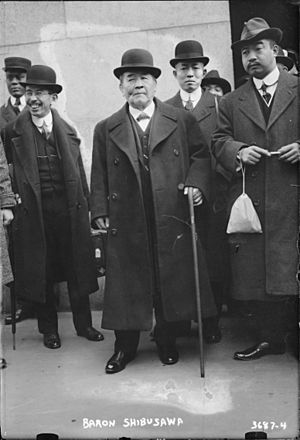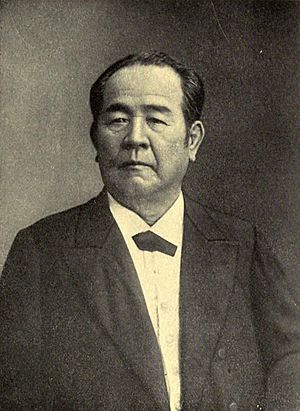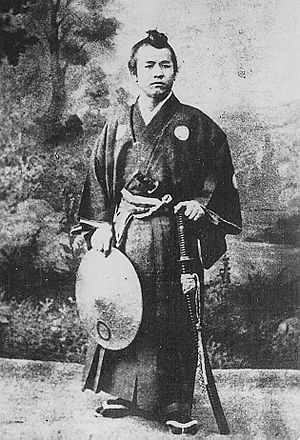Shibusawa Eiichi facts for kids

Shibusawa Eiichi (born March 16, 1840 – died November 11, 1931) was a very important Japanese businessman. Many people call him the "father of Japanese capitalism". He helped bring modern Western business ideas to Japan. This happened after a big change in Japan called the Meiji Restoration.
He introduced many new ways of doing business. These included using double-entry accounting (a way to keep track of money). He also started companies where many people could own parts of the business. He also created modern banks that could print their own money.
Shibusawa founded Japan's first modern bank. It was called The First National Bank. Today, it is part of Mizuho Bank. Through this bank, he helped start hundreds of other companies in Japan. Many of these companies are still around today. He also founded the Tokyo Stock Exchange, where companies' shares are bought and sold. He also started the Japanese Chamber of Commerce and Industry. Shibusawa helped create many hospitals, schools, and universities. This included the first university for women. He also helped build the Imperial Hotel in Tokyo. He supported charities like the Japan Red Cross.
Even though he started many companies, Shibusawa did not try to control them all. This stopped him from forming a zaibatsu. A zaibatsu was a large family-controlled business group. The Shibusawa zaibatsu was just a company to manage his family's money. It did not control other businesses. Shibusawa came from a farming family. But he was given the special title of Viscount. Other zaibatsu founders usually got a lower title, Baron. He also received a high honor called Shōnii. This honor was usually given to important nobles or prime ministers.
On April 9, 2019, Japan announced a big honor for Shibusawa. His picture will be on the new Japanese ¥10000 banknote. These new banknotes are expected to be used around 2024.
Contents
Shibusawa's Early Life
Shibusawa was born on March 16, 1840. He grew up on a farm in Chiaraijima. This area is now part of Fukaya City. When he was a boy, his father taught him to read and write. He helped with his family's farm business. They grew crops, made and sold indigo dye, and raised silk. Later, he studied important books about Confucianism. He also learned about the history of Japan from his cousin, Odaka Junchu.
When he was young, Shibusawa was influenced by a movement called sonnō jōi. This idea meant "respect the emperor and get rid of foreigners." He and his friends planned to take over Takasaki Castle. They also wanted to set fires in the foreign area of Yokohama. But they stopped this plan. Instead, he moved to Kyoto.
At 23, Shibusawa left his hometown. He began working for Tokugawa Yoshinobu. Yoshinobu was a powerful leader who later became the shōgun (Japan's military ruler). Shibusawa did a great job helping to make the Hitotsubashi family's money stronger.
Travels and New Ideas
When he was 27, Shibusawa visited France and other European countries. He went as part of a group with Tokugawa Akitake. They attended a big world fair called the Exposition Universelle (1867). On this trip, Shibusawa saw modern European societies for the first time. He realized how important it was for a country to develop its industries and economy.
After returning from Europe, he heard about the Meiji Restoration. This was a big change in Japan's government. He then started the Shōhō Kaishō. This was one of the first companies in Japan where many people could own shares. He started it in Shizuoka Prefecture. Later, the new Meiji government asked him to join the Ministry of Finance. There, he led a group called the Kaisei Kakari. This group was in charge of making reforms. He played a key role in building a modern Japan.
In 1873, Shibusawa left the Ministry of Finance. He became the president of the Dai-ichi Bank. This was Japan's first modern bank. He had helped set it up while he was still at the Ministry of Finance. With this bank as his base, Shibusawa worked hard to start and support many different businesses.
Business and Public Service
Shibusawa always believed that good ethics and business should work together. He was involved in starting or supporting over 500 businesses. Some of these include Mizuho Financial Group, The 77 Bank, Tokio Marine Nichido, Imperial Hotel, Tokyo Stock Exchange, Tokyo Gas, Toyobo, Tokyu Corporation, Keihan Electric Railway, Taiheiyo Cement, Oji Paper Company, Sapporo Breweries, and NYK Line. He was also president of the Tokyo Chamber of Commerce.
He also did a lot of work to improve society. He strongly supported education, especially higher education for business. He helped create schools like Hitotsubashi University and Tokyo Keizai University. He also supported higher education for women and private schools. Shibusawa was involved in about 600 projects. These projects were related to education, social welfare, and other good causes.
Shibusawa also worked to improve relationships between countries. He did this through private talks and visits. In 1902, he visited Germany, France, and the United Kingdom.
In 1908, Shibusawa and other Japanese business leaders welcomed the first official U.S. business group to Japan. This group was led by Frank A. Vanderlip. Shibusawa had invited them to Japan. He wanted to build stronger ties between the two countries. He also wanted to increase business and trade.
In 1909, the U.S. business group invited Shibusawa and his group to visit the United States. They traveled to 53 cities across the country. This trip covered 11,000 miles over three months.
In 1915, Shibusawa visited the United States again. The Japan Society of Manhattan held a dinner for him. Important people like former U.S. Presidents Theodore Roosevelt and William Howard Taft honored him. This showed the growing good relationship between the U.S. and Japan.
Shibusawa also had many important guests visit his home in Asukayama. They talked openly with him.
Shibusawa had worked for the last shogun of Japan, Tokugawa Yoshinobu. After the shogun's rule ended, Shibusawa remained friends with Yoshinobu's son, Prince Iyesato Tokugawa. These two leaders worked together to support democracy in Japan. They also worked to promote good relationships with the United States and other countries.
In 1917, during World War One, there was a lot of suffering in Europe. Prince Iyesato Tokugawa and Baron Eiichi Shibusawa represented Japan. They published a booklet to show sympathy for their allies. Japan not only helped its allies in the war. It also helped their sick and wounded soldiers. The booklet explained that Japan created a fund to help with health costs. Prince Iyesato Tokugawa was the president of this group. Shibusawa was a vice-president. Many Japanese leaders wrote articles for this booklet. It was published in French and English.
In 1930, Prince Iyesato Tokugawa and Baron Eiichi Shibusawa attended a special event. They were honoring the first United States Minister to Japan, Townsend Harris. A monument was unveiled to remember him. Townsend Harris came to Japan in 1856. He opened the first U.S. office in Japan. He also helped create the "Harris Treaty" between the U.S. and Japan. He is known for helping to open Japan to foreign trade and culture. Shibusawa became friends with Townsend Harris during his time in Japan.
Shibusawa died on November 11, 1931, when he was 91 years old.
Honors and Awards
Shibusawa received many important awards for his work:
- Grand Cordon of the Order of the Sacred Treasure (August 24, 1911)
- Grand Cordon of the Order of the Rising Sun with Paulownia Flowers (November 10, 1928)
- Senior Second Rank (November 10, 1931)
Shibusawa in Stories
Shibusawa appears as a character in some stories.
- He is a supporting character in the novel Teito Monogatari by Aramata Hiroshi. This book is a historical fantasy set during the Meiji Restoration.
- In the 1988 movie Tokyo: The Last Megalopolis, he is played by the actor Katsu Shintarō.
- In the animated version, his voice is done by Osamu Saka.
- Baron Shibusawa is also featured in the historical novel The Emperor and the Spy by Stan S. Katz. In this book, he helps people injured during the 1923 Great Kantō earthquake. The book also shows the friendship between Shibusawa and Prince Iesato Tokugawa.
| Contributing editor: Stan S. Katz Dr. Stan S. Katz is the author of The Emperor and the Spy, The Art of Diplomacy , and The Art of Peace. |
See also
 In Spanish: Eiichi Shibusawa para niños
In Spanish: Eiichi Shibusawa para niños




